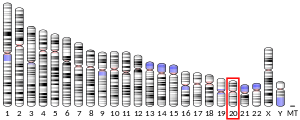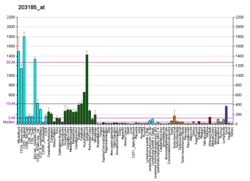RASSF2
Ras association domain-containing protein 2 is a protein that in humans is encoded by the RASSF2 gene.[5][6][7]
This gene encodes a protein that contains a Ras association domain. Similar to its cattle and sheep counterparts, this gene is located near the prion gene. Two alternatively spliced transcripts encoding the same isoform have been reported.[7]
Interactions
RASSF2 has been shown to interact with KRAS.[8]
gollark: Except it's easy to damage and inconvenient.
gollark: Also when, potentially.
gollark: Well, they know what site you use.
gollark: Github (MS) is probably okay ish?
gollark: I just never make things which people can sign up for.
References
- GRCh38: Ensembl release 89: ENSG00000101265 - Ensembl, May 2017
- GRCm38: Ensembl release 89: ENSMUSG00000027339 - Ensembl, May 2017
- "Human PubMed Reference:". National Center for Biotechnology Information, U.S. National Library of Medicine.
- "Mouse PubMed Reference:". National Center for Biotechnology Information, U.S. National Library of Medicine.
- Nagase T, Seki N, Ishikawa K, Tanaka A, Nomura N (Nov 1996). "Prediction of the coding sequences of unidentified human genes. V. The coding sequences of 40 new genes (KIAA0161-KIAA0200) deduced by analysis of cDNA clones from human cell line KG-1". DNA Res. 3 (1): 17–24. doi:10.1093/dnares/3.1.17. PMID 8724849.
- Hesson LB, Wilson R, Morton D, Adams C, Walker M, Maher ER, Latif F (Jun 2005). "CpG island promoter hypermethylation of a novel Ras-effector gene RASSF2A is an early event in colon carcinogenesis and correlates inversely with K-ras mutations". Oncogene. 24 (24): 3987–94. doi:10.1038/sj.onc.1208566. PMID 15806169.
- "Entrez Gene: RASSF2 Ras association (RalGDS/AF-6) domain family 2".
- Vos, Michele D; Ellis Chad A; Elam Candice; Ulku Aylin S; Taylor Barbara J; Clark Geoffrey J (Jul 2003). "RASSF2 is a novel K-Ras-specific effector and potential tumor suppressor". J. Biol. Chem. United States. 278 (30): 28045–51. doi:10.1074/jbc.M300554200. ISSN 0021-9258. PMID 12732644.
Further reading
- Maruyama K, Sugano S (1994). "Oligo-capping: a simple method to replace the cap structure of eukaryotic mRNAs with oligoribonucleotides". Gene. 138 (1–2): 171–4. doi:10.1016/0378-1119(94)90802-8. PMID 8125298.
- Suzuki Y, Yoshitomo-Nakagawa K, Maruyama K, et al. (1997). "Construction and characterization of a full length-enriched and a 5'-end-enriched cDNA library". Gene. 200 (1–2): 149–56. doi:10.1016/S0378-1119(97)00411-3. PMID 9373149.
- Comincini S, Castiglioni BM, Foti GM, et al. (2001). "Isolation and molecular characterization of rasfadin, a novel gene in the vicinity of the bovine prion gene". Mamm. Genome. 12 (2): 150–6. doi:10.1007/s003350010239. PMID 11210185.
- Deloukas P, Matthews LH, Ashurst J, et al. (2002). "The DNA sequence and comparative analysis of human chromosome 20". Nature. 414 (6866): 865–71. Bibcode:2001Natur.414..865D. doi:10.1038/414865a. PMID 11780052.
- Strausberg RL, Feingold EA, Grouse LH, et al. (2003). "Generation and initial analysis of more than 15,000 full-length human and mouse cDNA sequences". Proc. Natl. Acad. Sci. U.S.A. 99 (26): 16899–903. Bibcode:2002PNAS...9916899M. doi:10.1073/pnas.242603899. PMC 139241. PMID 12477932.
- Vos MD, Ellis CA, Elam C, et al. (2003). "RASSF2 is a novel K-Ras-specific effector and potential tumor suppressor". J. Biol. Chem. 278 (30): 28045–51. doi:10.1074/jbc.M300554200. PMID 12732644.
- Gerhard DS, Wagner L, Feingold EA, et al. (2004). "The status, quality, and expansion of the NIH full-length cDNA project: the Mammalian Gene Collection (MGC)". Genome Res. 14 (10B): 2121–7. doi:10.1101/gr.2596504. PMC 528928. PMID 15489334.
- Fujita H, Fukuhara S, Sakurai A, et al. (2005). "Local activation of Rap1 contributes to directional vascular endothelial cell migration accompanied by extension of microtubules on which RAPL, a Rap1-associating molecule, localizes". J. Biol. Chem. 280 (6): 5022–31. doi:10.1074/jbc.M409701200. PMID 15569673.
- Akino K, Toyota M, Suzuki H, et al. (2005). "The Ras effector RASSF2 is a novel tumor-suppressor gene in human colorectal cancer". Gastroenterology. 129 (1): 156–69. doi:10.1053/j.gastro.2005.03.051. PMID 16012945.
- Endoh M, Tamura G, Honda T, et al. (2006). "RASSF2, a potential tumour suppressor, is silenced by CpG island hypermethylation in gastric cancer". Br. J. Cancer. 93 (12): 1395–9. doi:10.1038/sj.bjc.6602854. PMC 2361541. PMID 16265349.
- Zhang Z, Sun D, Van do N, et al. (2007). "Inactivation of RASSF2A by promoter methylation correlates with lymph node metastasis in nasopharyngeal carcinoma". Int. J. Cancer. 120 (1): 32–8. doi:10.1002/ijc.22185. hdl:10616/38128. PMID 17013896.
- Park HW, Kang HC, Kim IJ, et al. (2007). "Correlation between hypermethylation of the RASSF2A promoter and K-ras/BRAF mutations in microsatellite-stable colorectal cancers". Int. J. Cancer. 120 (1): 7–12. doi:10.1002/ijc.22276. PMID 17013898.
- Kumari G, Singhal PK, Rao MR, Mahalingam S (2007). "Nuclear transport of Ras-associated tumor suppressor proteins: different transport receptor binding specificities for arginine-rich nuclear targeting signals". J. Mol. Biol. 367 (5): 1294–311. doi:10.1016/j.jmb.2007.01.026. PMID 17320110.
- Kaira K, Sunaga N, Tomizawa Y, et al. (2007). "Epigenetic inactivation of the RAS-effector gene RASSF2 in lung cancers". Int. J. Oncol. 31 (1): 169–73. doi:10.3892/ijo.31.1.169. PMID 17549418.
This article is issued from Wikipedia. The text is licensed under Creative Commons - Attribution - Sharealike. Additional terms may apply for the media files.




